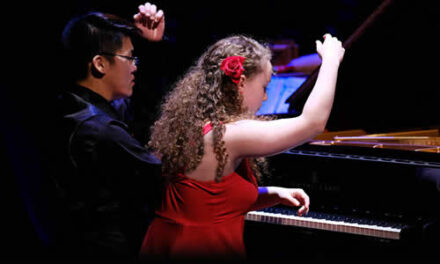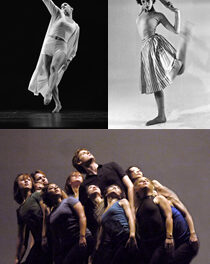Pianist Ivan Moshchuk returned to Raleigh for his fourth big concert here in three years, on this occasion appearing for the first time in Meredith College’s Clara Carswell Concert Hall.
Make note of the name.
For his local debut, at St. Mary’s School, Moshchuk chose an all-Russian program consisting of music by Medtner and Scriabin, capped by Rachmaninoff’s Sonata No. 2; critic Paul D. Williams concluded his review with a paragraph that seemed to glow from within:
“So here is a young artist with matinee good looks and admirable stage presence. He has won more than his fair share of prestigious awards. He is currently privileged to study piano performance with Leon Fleisher (who studied with Schnabel!). What’s to prevent him from eventually assuming his place in the front row with this world’s great pianists?”
He came back to Smedes Parlor the following season to perform Mozart, Beethoven, and the Liszt Sonata, a knuckle-buster of a piece comparable in technical terms with the aforementioned Rachmaninoff.
Last fall he was back for an all-Chopin program in the same venue – the first two ballades, the Op. 27 nocturnes, and the Sonata No. 3, in B minor.
At Carswell, on a night that promised (but fortunately failed to deliver) freezing rain, he again offered an all-Chopin program, this time bookended by both of the well-known sonatas,* that is to say the third – the finale of which truly separates pianistic sheep from goats of heroic size (to crush a metaphor) – and the famous second, known as the “Funeral March” Sonata. In between came the three reflective mazurkas of Op. 59 and the second scherzo.
The Sonata No. 3, in B minor, Op. 58, first appeared on this writer’s radar over 50 years ago in the form of a well-worn copy of William Kapell’s RCA Lp found at the PTA Thrift Shop in Chapel Hill. On the cover of this record someone at WUNC-FM (which, long before it abandoned music for talk and re-wrote its history, too, was a little campus station based in Swain Hall, operated largely by students) had written “NBQ” (“not broadcast quality”) in black grease pencil…. Kapell was the most prominent of the group of pianists who came to be known as the OYAPs – “outstanding young American pianists.” His tragic death in a plane crash in 1953, at the age of 31, is still mourned by keyboard aficionados of a certain age.
But I digress.
For this listener, Kapell set the standards for performance of Chopin’s Sonata No. 3, and by those standards, all others are perforce measured. I’ve heard lots of performances of it over the years. Most have disappointed. Moshchuk did not. This performance in Carswell had everything going for it. It was quite simply one of the very best renditions I have heard in over 50 years. And overall, his playing easily made this program among the most impressive I have heard in a lifetime of listening. It was that good.
He’s definitely a pianist who covers a lot of territory with speed and dexterity without taking any prisoners, as someone once said of an outstanding general. The sonata began like a house afire and continued without letup in intensity to a completely stunning finale, delivered in tempo without pauses or hesitation of any kind. There were reflective moments, of course, and passages both elegant and serene, but one was always aware of the artist’s intention to project the work as a unified whole. The word that comes to mind in connection with the way Moshchuk ended this piece is “thrilling,” a word critics must always use with trepidation and restraint. Yes, it was that good.
The mazurkas followed, wonderfully reflective miniatures but not without their share of emotion and drama. They might have made an even greater effect had they preceded the sonata, but as they were, they cleansed the palate with their varied keys (A minor, A-Flat, and F-Sharp minor) before the all-B-Flat minor second half.
After a brief intermission, there followed the Scherzo No. 2 (replacing the previously-announced first one); this was magnificently realized, technically and artistically, and given with keen insight and tremendous contrasts among and between its component parts. This certainly heated up the crowd again, and the visiting artist’s intense reading continued to hold many in attendance in almost breathless captivation. Then the opening movements of the Sonata No. 2 seemed ideally projected to emphasize the work’s poignant and dramatic funeral march; and for a change even the score’s sort-of throw-away finale proved insightful as a denouement from the sonata’s earlier tensions.
Although for ordinary players the two sonatas and the accompanying works would have been more than sufficient, it did not take much carrying-on from the audience to elicit an encore. Even that was unusual, in the evening’s context: he selected a Bach prelude, as transcribed by Alexander Siloti, a piece not heard hereabouts since the heyday of Ray Kilburn at what was then Peace College. Its calmness brought the crowd back down from the empyrean heights.
Wow.
Moshchuk’s bio reveals that “He is currently a doctoral candidate at the University of Cincinnati College-Conservatory where he serves as the assistant of faculty artist James Tocco.”
Make note of the name.
*We asked Meredith’s senior pianist Kent Lyman about Chopin’s Sonata No. 1, which no one we know has ever heard played “live.” It is apparently a less-than-totally-cohesive early work, albeit a substantial one. Readers may listen to it here, on YouTube, as played by Leif Ove Andsnes.












